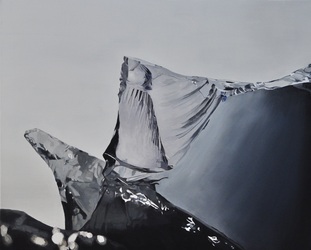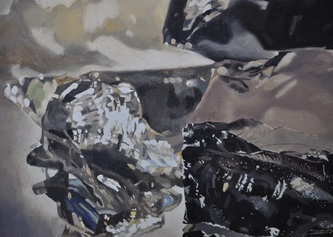Permanently elevated, never to return, in to pure space
Oil on canvas
2013
'Permanently elevated, never to return, in to pure space' questions ideas of success and failure, both on a macro and micro level and explores in a transfigurative fashion, the possible repercussions of both. Painting as a method can be viewed as one whose conclusion relies heavily on a series of usually deliberate choices. The painted surface records these actions and choices, bringing a degree of four dimensionality to the fore. These choices carry inherent implications of success and failure, of excitement and anxiety, only occasionally resolved in the completed object. As such it is a method suited to interrogating decision-making processes, the effects of power and powerlessness that run through society and resonate in the slightest physical sensation of every individual. That, in other words, of which mass media images are symptomatic at best, but which dictates the placement and presentation of these images themselves. This is the methods strength in an era where painting as a medium has reached a certain degree of saturation, competing with the mass media image pool. It allows us to play out the micro-mechanics of decision-making in the realm of applying paint to canvas, even envisioning possible new decisions.
In this instance, the idea of the decision making process and its inherent anxiety is visualised in the form of a fantastical and speculative, science fiction style crystal landscape. Taking a cue from a novel by J.G. Ballard, this world appears harsh and unforgiving, full of jagged edges and stark precipices. But it is also a vision of a beautiful world, of glittering walls and clear light, a transfiguration of living and inanimate things. It is a world that follows it's own rationalism and internal logic, much like it's method of realisation. It presents a dialectical representation of the world and it's decision making dynamics; success and failure, excitement and anxiety, power and powerlessness. But it then proceeds to undermine itself with the realisation that the image is in truth a still life made up of shards of glass from the screen of a television – hence returning the discussion and process to the idea of the mass media image pool.






